Cisco and Intel present a new analytics solution, Intel Connectivity Analytics, that gives granular driver-level wireless client insights for any client using the latest Intel driver and wireless chipsets while connected to a supported Cisco wireless network (visit Intel Connectivity Analytics FAQ for the SW/HW compatibility matrix). This feature significantly impacts the enterprise PC vertical, where Intel Wi-Fi 6/6E chipsets make up the majority of the market share. With the Intel Connectivity Analytics capability built directly into the Intel wireless drivers, it eliminates the need to install any client-side agent, enabling this feature to be leveraged in even non-corporate settings.
More than just telemetry, Intel Connectivity Analytics provides intelligent reports that allow network administrators to understand what to do next for any problem and ensure a great user experience in even the most complex wireless deployments by addressing the use cases in Figure 1 below.
Figure 1. Intel Connectivity Analytics Use Cases
Six Intelligent Reports to Solve All Your Problems
Intel Connectivity Analytics generates six reports (Figure 2) in real-time based on information forwarded by wireless clients to the AP and then Cisco Catalyst controller or Meraki Dashboard that directly addresses the use cases depicted in Figure 1.
Note: Station information, Neighboring AP, and Failed AP reports are generated at client association, while others are triggered when the situation arises.
Figure 2. Intel Connectivity Analytics Reports Details
Identifying out-of-date Driver, Validating New Drivers, and Identifying Hardware issues:
The Station Information report provides network administrators with driver-level client information that would not have been available in typical telemetry. This additional information allows network administrators to pinpoint the specifications such as software driver or hardware model that clients experiencing poor Wi-Fi are on and target just them.
Figure 3. Identifying Hardware Issues with Intel Connectivity Analytics
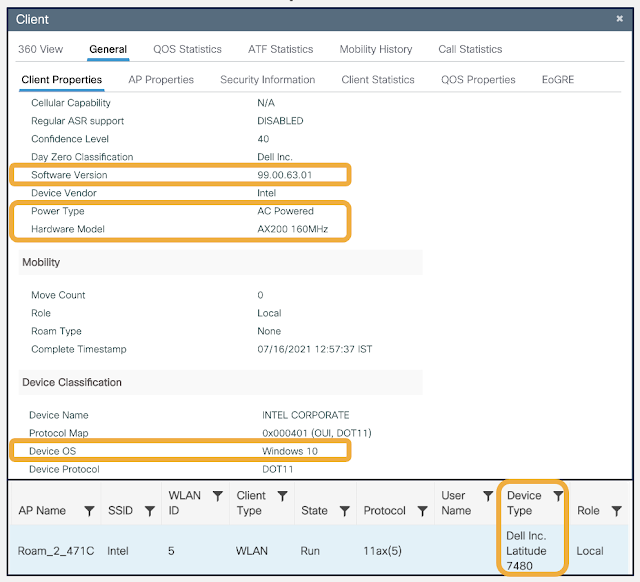 Figure 4. Station information or Device Classifier WebUI Output on the Catalyst 9800 Controller
Figure 4. Station information or Device Classifier WebUI Output on the Catalyst 9800 Controller
Outdated wireless drivers can also be a common culprit for a poor wireless experience. The station information report gives network administrators peace of mind when rolling out software updates knowing they have complete visibility on the Catalyst or Meraki controller.
Figure 5. Identifying Out of Date Drivers (Left) & Validating New Drivers (Right) with Client Connectivity Analytics
Troubleshooting Roaming:
When a client roams, it’s entirely a wireless client’s decision to do so, and the network has little to no visibility into the reason. Thanks to Intel Connectivity Analytics, we have reports that will share these insights with reason codes such as Low RSSI, 11v Recommendations, Missed Beacons, and Better AP. Based on these insights, a network administrator can determine whether the suspicious client roam was for a legitimate reason or not.
Figure 6. Troubleshooting Roaming with Client Connectivity Analytics
Figure 7. Roaming Scenario Report WebUI Output on the Catalyst 9800 Controller
Identifying Poor Connectivity:
When a wireless client’s RSSI falls below a certain threshold, a Low RSSI report will be generated to alert network administrators about possible coverage holes. These issues can then be proactively addressed by increasing the Tx power on an AP, deploying additional APs, and monitoring if more Low RSSI reports are generated.
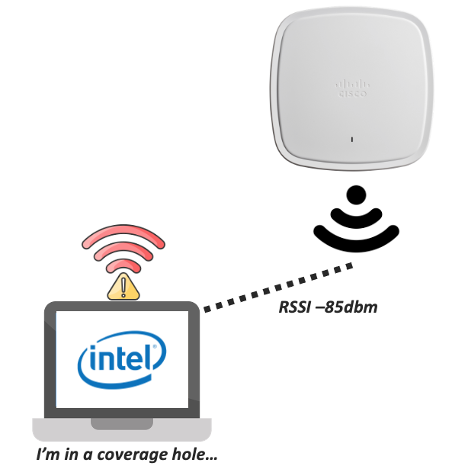
Figure 8. Identifying Poor Connectivity with Client Connectivity Analytics
Identifying Misbehaving APs:
Intel Connectivity Analytics supported clients will report if an AP is broadcasting invalid IEs in their beacons, probes, and association responses that would cause connectivity and security concerns. In fact, failed AP reports will even go deeper at the packet level and highlight problematic authentication frames, association frames, or missing response frames.
Intel Connectivity Analytics can even detect rogue AP behavior with the Unknown AP report, which is used to identify and flag rogue BSSID’s (BSSIDs that are not part of an earlier neighbor report)
Figure 9. Identifying Misbehaving APs with Client Connectivity Analytics
Figure 10. Unknown AP Report CLI Output on the Catalyst 9800 Controller
How Does It Work?
Intel Connectivity Analytics uses a Cisco Catalyst 9800 series controller and Catalyst 9100 access point topology from the Cisco Enterprise Network side. The controller enables the features by default on a per WLAN basis. Intel Connectivity Analytics supported client sends the driver-level telemetry back to the access point, which is then processed and presents users with intelligent reports and insights.
Figure 11. Intel Connectivity Analytics Topology
For a technical understanding, refer to the following points:
1. All Intel Connectivity Analytics packet exchanges are protected using PMF for security purposes.
2. Cisco network running IOS XE 17.6.1 or later with the feature enabled will advertise Intel Connectivity Analytics feature support in the Beacon frames.
3. Supported Intel clients will detect and begin forwarding telemetry periodically via a protected Action frame.
As you can see, Intel Connectivity Analytics provides network administrators with granular client-side telemetry in an agentless package at a level never seen in the past. With its wide range of use cases, minimum day 0 requirements, there’s no reason why you wouldn’t leverage such a powerful wireless analytics solution! Take the wireless experience of your network to the next level with Intel Connectivity Analytics today!
Source: cisco.com
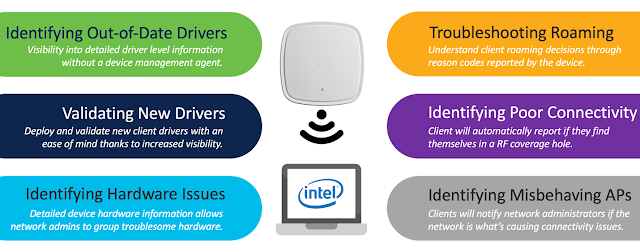
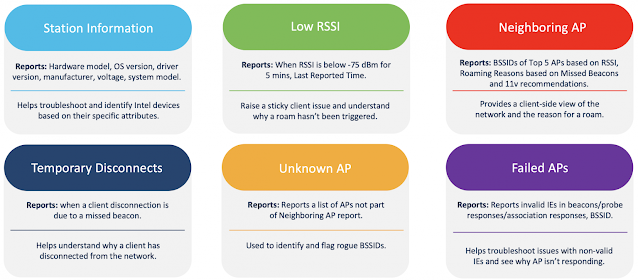
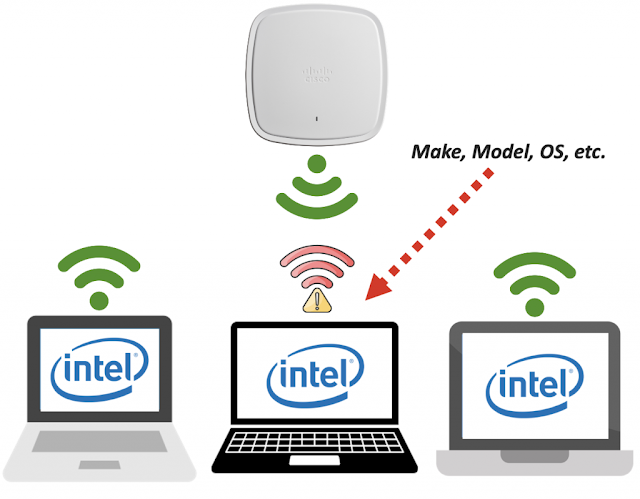












0 comments:
Post a Comment